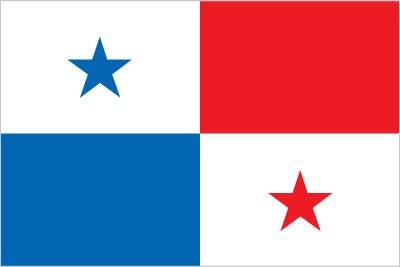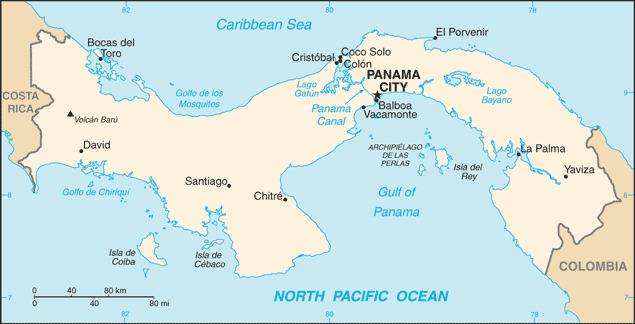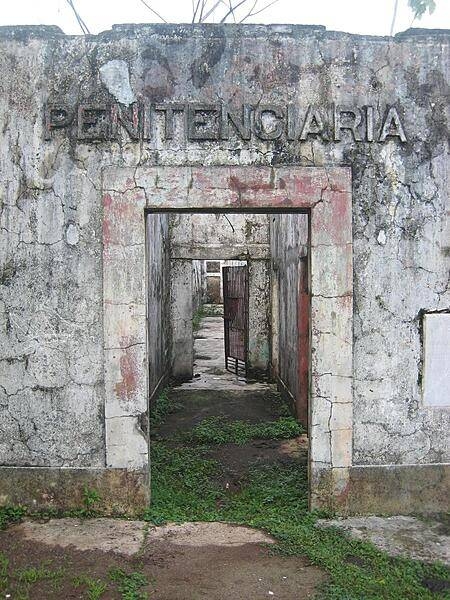27 Panama

Divided into four, equal rectangles. The top quadrants are white (hoist side) with a blue five-pointed star in the center and plain red. The bottom quadrants are plain blue (hoist side) and white with a red five-pointed star in the center. The blue and red colors are those of the main political parties (Conservatives and Liberals respectively) and the white denotes peace between them. The blue star stands for the civic virtues of purity and honesty, the red star signifies authority and law.
Flag courtesy of the CIA World Factbook

Map courtesy of CIA World Factbook

The ruins of a jungle prison on the island of Coiba in Panama. The entire island was once a penal colony, but is now a nature reserve. The last few prisoners, who have no other home, tend the ruins of the main prison grounds.
Photo courtesy of the CIA World Factbook
Government
According to Britannica, Panama has a popularly elected, representative system of government with executive, legislative, and judicial branches. Universal suffrage was instituted in 1907, and Panamanians 18 years of age and older are eligible to vote.
After a coup by the National Guard in 1968, the national legislature was suspended, and Panama was administered by a provisional government led by Gen. Omar Torrijos. A new constitution in 1972, the fourth in Panama’s history, gave Torrijos virtually complete control over the government but also established an elected body, the National Assembly of Municipal Representatives. The constitution was amended in 1978 to provide for a gradual return to democratic government within six years. Further constitutional amendments were approved in 1983, but democracy did not return to Panama until 1990, following the removal of Torrijos’s successor, Gen. Manuel Antonio Noriega Morena.
Under the constitutional revision of 1983, executive power is exercised by the president, who is popularly elected for a nonrenewable five-year term. The president was assisted by two vice presidents, also popularly elected for nonrenewable five-year terms, until 2009, when the second vice presidential position was eliminated. The president appoints a cabinet. A unicameral National Assembly consists of 71 members, who are elected for five-year terms and are eligible for reelection. The assembly initiates legislation, rules on international treaties, approves the budget, and establishes political divisions. After the 2014 election nearly one-fifth of the seats were held by women.
The country is divided into 10 provincias and three comarcas (indigenous sectors), Kuna Yala (San Blas), Emberá (Emberá-Wounaan), and Ngöbe Buglé (Guaymí). The provincias are divided into distritos municipales (municipal districts), which are subdivided into corregimientos (magistracies). The head of each provincia is the governor, appointed by the president. The comarcas are semiautonomous reserves governed by tribal leaders (caciques), but their status under the law has been disputed. In the late 1990s indigenous protestors in some comarcas clashed with the national police while opposing the expansion of industrial sites and roads on the reserves. In addition, some Kuna have attempted to control tourism in the San Blas islands.
Judicial power rests with a Supreme Court, the nine members of which are appointed for 10-year terms by the president with the approval of the National Assembly. The Supreme Court is composed of separate divisions for civil, penal, and administrative cases. The justice system also includes several types of lower courts.
Civil Aviation Authority of Panama
Civil Aviation Authority of Panama is the organization in charge of directing and regulating the operation and development of civil aviation in a safe, orderly and efficient manner, to satisfy the requirements of users and contribute to the welfare of society in general.
Airspace
SkyVector – Google Maps – ADS-B Exchange
ICAO countries publish an Aeronautical Information Publication (AIP). This document is divided into three parts: General (GEN), En Route (ENR) and Aerodromes (AD). ENR 1.4 details the types of airspace classes they chose to adopt from classes A through G.
Panama AIP (there is a fee associated with this)
Drone Regulations
Drone Laws listed on the government website of the CAA
Drone Laws (not translated)
Advanced Air Mobility (AAM) Regulations & Policies
None found by the author.
However, should you, the reader, happen to stumble across something to the contrary, please email the author at FISHE5CA@erau.edu and you may be mentioned in the ACKNOWLEDGEMENTS section of this book by way of thanks for contributing to this free eBook!
Advanced Air Mobility (AAM) News
None found by the author.
However, should you, the reader, happen to stumble across something to the contrary, please email the author at FISHE5CA@erau.edu and you may be mentioned in the ACKNOWLEDGEMENTS section of this book by way of thanks for contributing to this free eBook!
Short Essay Questions
Scenario-Based Question
You have been hired by a Drone Startup Company. Your boss has immediately assigned this job to you.
They need you to prepare a one-page memo detailing the legalities of using a drone on the island of Coiba, pictured above.
They need you to mention any national laws and local ordinances.
They specifically want to know what airspace (insert pictures) you will be operating in and whether or not you need an airspace authorization.
Does it matter whether or not you are a citizen of the country?
Lastly, there is a bonus for you if, as you scroll through this chapter, you find any typos or broken links!
Short Essay Questions
- What are the drone categories?
- How is registration addressed?
- How is remote ID addressed?
- What are the model aircraft rules?
- What are the commercial drone rules?
- Are there waivers or exemptions to the rules? If so, for what?
- Would you share a link to an interactive airspace map?
- How is BVLOS addressed?
- How can you fly drones at night?
- How can you fly drones over people?
- Where do you find drone NOTAMs?
- What are the rules for drone maintenance?
- What are the rules for an SMS program?
- What are some unique rules not mentioned above?
- What are the C-UAS rules?
- What are the AAM rules?

